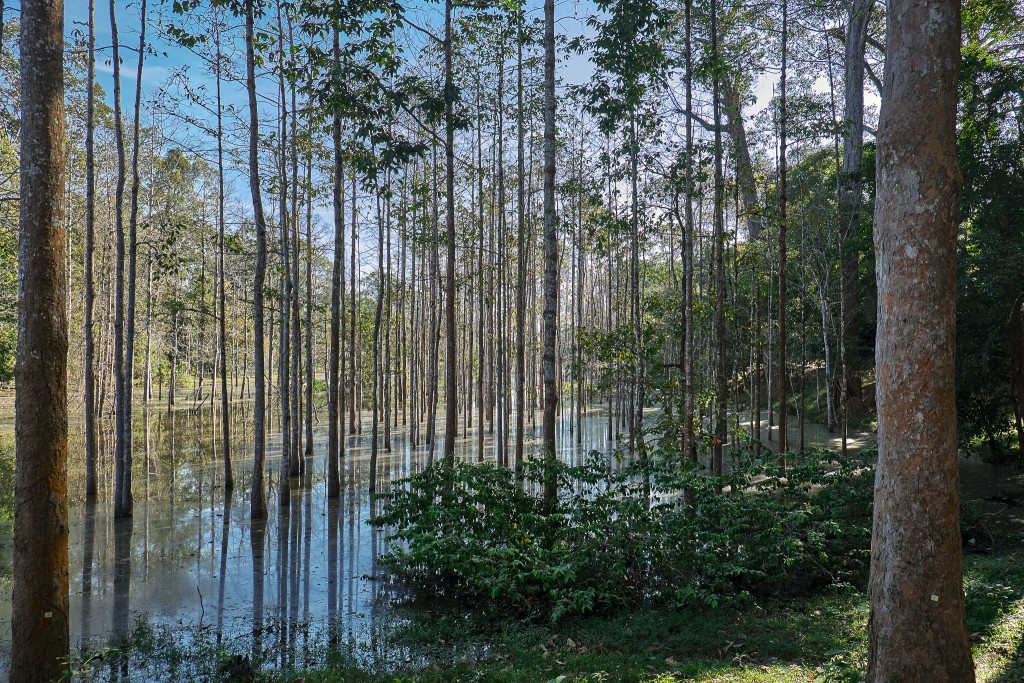Cambodia’s national parks (or ‘natural parks’) and wildlife sanctuaries were established under the 1993 Royal Decree on Creation and Designation of the Natural Protected Areas.

Flooded trees outside of Angkor Thom’s north gate. Photo by Mild Delirium, taken on 25 December 2014. Licensed under CC BY-NC-ND 2.0.
The list below contains the recognized protected areas as established in the 1993 royal decree. Although other areas have been added subsequently, there is currently no officially available list of all protected areas and their boundaries.1
Natural parks
Areas reserved for nature and scenic views. To be protected for scientific, educational and entertainment purposes:
- Kirirom (Kampong Speu and Koh Kong) 35,000 hectares
- Bokor (Kampot) 140,000 hectares
- Kep (Kampot) originally 5,000 hectares, later amended to 1,152 hectares
- Ream (Kampong Som) 150,000 hectares
- Botum Sakor (Koh Kong) 171,250 hectares
- Phnom Koulen (Siem Reap) 37,500 hectares
- Virachey (Stung Treng and Ratanik Kiri) 332,500 hectares
Wildlife sanctuaries
Areas preserved in their natural condition to protect wildlife, vegetation and ecological balance:
- Phnom Aural (Koh Kong, Pursat, Kampong Chhnang) 253,750 hectares
- Peam Krasop (Koh Kong) 23,750 hectares
- Phnom Samkos (Koh Kong) 333,750 hectares
- Roneam Donsam (Battambang) 178,750 hectares
- Koulen Prum Tep (Siem Reap and Preah Vihear) 402,500 hectares
- Beng Per (Kampong Thom) 242,500 hectares
- Lumphat (Ratanak Kiri and Mondul Kiri) 250,000 hectares
- Phnom Prich (Mondul Kiri and Kratie) 222,500 hectares
- Phnom Namlear (Mondul Kiri) 47,500 hectares.
Wildlife sanctuaries can also be dissolved by royal decree. In February 2018 the Snuol Wildlife Sanctuary in Kratie (covering 75,000 hectares and established in 1993) and the Roneam Daun Sam Wildlife Sanctuary in Battambang province (covering 39,961 hectares and established in 2003) were dissolved.2
Ramsar sites
A separate protection move was made in June 1999, when three wetland areas were designated as ‘Ramsar sites’ under the Ramsar Convention.3 This intergovernmental treaty recognises the ecological importance of key wetlands and the need to plan for their sustainable use. These sites are under the management authority of the Department of Freshwater Wetlands Conservation of the Ministry of Environment.
The 5 Ramsar sites (as of 30 November 2018)4 are:
- A stretch of the Mekong River approximately 37 km long and 14,600 hectares in Stung Treng Province
- Boeng Chhmar and associated river system and floodplain, 28,000 hectares in Kampong Thom and Siem Reap provinces (part of a designated multiple use area)
- Koh Kapik and associated islets, 12,000 hectares in Koh Kong province (part of a designated wildlife sanctuary)
- Prek Toal waterbird colony of 21,342 hectares (SouthEast Asia’s largest waterbird colony) was declared the 4th Ramsar site in October 2015
- Stung Sen, along the south-eastern edge of the Tonle Sap Great Lake, and mainly comprises seasonally flooded freshwater swamp forests. Declared the 5th Ramsar site in November 2018.
Last updated: 23 May 2019
Related to national parks and wildlife sanctuaries
References
- 1. Royal Decree on Creation and Designation of the Natural Protected Areas 1993, Article 1 & 2.
- 2. Pech Sotheary. “Government dissolves two wildlife sanctuaries.” Khmer Times, 19 March 2018. http://www.khmertimeskh.com/50114695/government-dissolves-two-wildlife-sanctuaries/ Accessed 23 March 2018
- 3. The Ramsar Convention on Wetlands. 2012. “The Annotated Ramsar List: Cambodia.” Accessed 23 April 2015. https://www.ramsar.org/wetland/cambodia
- 4. Ramsar. 2014. “Country profile: Cambodia.” Accessed 23 May 2019. https://www.ramsar.org/wetland/cambodia

